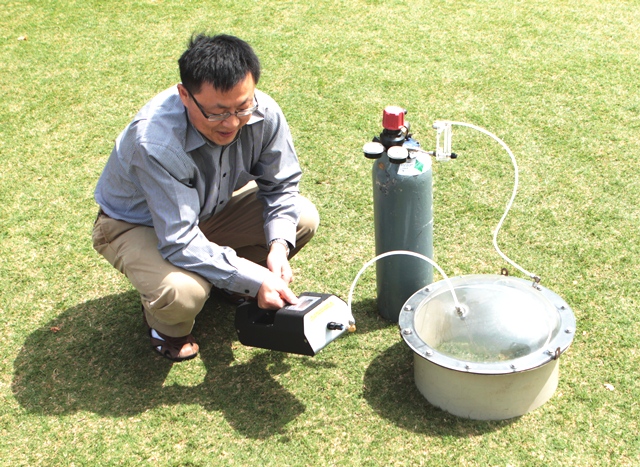Emission sampling and storage
 Prior to analysis of emissions, samples need to be collected from sources and transported to the laboratory.
Prior to analysis of emissions, samples need to be collected from sources and transported to the laboratory.
Emission collection
Flux hood methods
Fluxhoods are a common method for collecting emissions from passive surface such as liquid surfaces (lagoons, settling ponds) and porous media (biosolids, soils). They use a consistent sweep flowrate of an inert gas (N2) to generate an emissions in a controlled setting, removing effects of concentration and equilibria associated with headspace or passive systems.
Wind tunnels are similar however use higher directionals sweep gas flowrates to simulate the effect of wind.
Gas storage and transportation
Gas sampling bags
A variety of materials can be used to prepare gas sampling bags, in the UNSW Odour Lab, Nalophan and Tedlar bags are predominantly used. However, the stability of certain samples should be initially tested to determine the effect of transportation or storage times on compound recovery.
Sorbent tubes
Sorbent tubes allow the preconcentration and storage of volatile compounds. A variety of sorbent materials including Tenax TA, Carbotrap are available in the laboratory. Emissions can be collected in-situ or from sampling bags using vacuum pumps. However, stability of compounds, size of target analytes and humidity of samples should be evaluated prior to use.
To find out more about these methods, get in touch with Odour@unsw.edu.au
Relevant Publications
Liu L; Abdala Prata Junior A; Fisher RM; Stuetz RM, 2022, 'Measuring volatile emissions from biosolids: A critical review on sampling methods', Journal of Environmental Management, vol. 317, pp. 115290, http://dx.doi.org/10.1016/j.jenvman.2022.115290
Le H.V., Sivret E.C., Parcsi G., Stuetz R.M. (2015) Impact of storage conditions on the stability of volatile sulfur compounds in sampling bags. Journal of Environmental Quality 44, 1523 – 1529 https://doi.org/10.2134/jeq2014.12.0532




